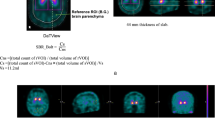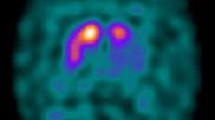Abstract
Visual and semi-quantitative assessments of 123I-FP-CIT single-photon emission computed tomography (SPECT) are useful for the diagnosis of dopaminergic neurodegenerative diseases (dNDD), including Parkinson’s disease, dementia with Lewy bodies, progressive supranuclear palsy, multiple system atrophy, and corticobasal degeneration. However, the diagnostic value of combined visual and semi-quantitative assessment in dNDD remains unclear. Among 239 consecutive patients with a newly diagnosed possible parkinsonian syndrome who underwent 123I-FP-CIT SPECT in our medical center, 114 patients with a disease duration less than 7 years were diagnosed as dNDD with the established criteria or as non-dNDD according to clinical judgment. We retrospectively examined their clinical characteristics and visual and semi-quantitative assessments of 123I-FP-CIT SPECT. The striatal binding ratio (SBR) was used as a semi-quantitative measure of 123I-FP-CIT SPECT. We calculated the sensitivity and specificity of visual assessment alone, semi-quantitative assessment alone, and combined visual and semi-quantitative assessment for the diagnosis of dNDD. SBR was correlated with visual assessment. Some dNDD patients with a normal visual assessment had an abnormal SBR, and vice versa. There was no statistically significant difference between sensitivity of the diagnosis with visual assessment alone and semi-quantitative assessment alone (91.2 vs. 86.8%, respectively, p = 0.29). Combined visual and semi-quantitative assessment demonstrated superior sensitivity (96.7%) to visual assessment (p = 0.03) or semi-quantitative assessment (p = 0.003) alone with equal specificity. Visual and semi-quantitative assessments of 123I-FP-CIT SPECT are helpful for the diagnosis of dNDD, and combined visual and semi-quantitative assessment shows superior sensitivity with equal specificity.


Similar content being viewed by others
References
Catafau AM, Tolosa E (2004) Impact of dopamine transporter SPECT using 123I-ioflupane on diagnosis and management of patients with clinically uncertain parkinsonian syndromes. Mov Disord 19:1175–1182
Bajaj N, Hauser RA, Grachev ID (2013) Clinical utility of dopamine transporter single photon emission CT (DaT-SPECT) with (123I) ioflupane in diagnosis of parkinsonian syndromes. J Neurol Neurosurg Psychiatry 84:1288–1295
Benamer HTS, Patterson J, Grosset DG (2000) Accurate differentiation of parkinsonism and essential tremor using visual assessment of [123I]FP-CIT SPET imaging: the[123I]FP-CIT SPET study group. Mov Disord 15:503–510
Hughes AJ, Daniel SE, Kilford L et al (1992) Accuracy of clinical diagnosis of idiopathic Parkinson’s disease. A clinico-pathological study of 100 cases. J Neurol Neurosurg Psychiatry 55:181–184
McKeith IG, Dickson DW, Lowe J et al (2005) Diagnosis and management of dementia with Lewy bodies: third report of the DLB consortium. Neurology 65:1863–1872
Gilman S, Wenning GK, Low PA et al (2008) Second consensus statement on the diagnosis of multiple system atrophy. Neurology 71:670–676
Litvan I, Agid Y, Calne D et al (1996) NINDS-Society for PSP, Inc. (SPSP) diagnostic criteria. Neurology 47:1–9
Armstrong MJ, Litvan I, Lang AE et al (2013) Criteria for the diagnosis of corticobasal degeneration. Neurology 80:496–503
Tossici-Bolt L, Hoffmann SM, Kemp PM et al (2006) Quantification of [123I]FP-CIT SPECT brain images: an accurate technique for measurement of the specific binding ratio. Eur J Nucl Med Mol Imaging 33:1491–1499
FDA prescribing information for DaTscan website. http://www.accessdata.fda.gov/drugsatfda_docs/nda/2011/022454sOrig1s000Lbl.pdf. Accessed 9 Jan 2017
Seret A, Nguyen D, Bernard C (2012) Quantitative capabilities of four state-of-the-art SPECT-CT cameras. EJNMMI Res 2:45
Utiumi MA, Felicio AC, Borges CR et al (2012) Dopamine transporter imaging in clinically unclear cases of parkinsonism and the importance of scans without evidence of dopaminergic deficit (SWEDDs). Arq Neuropsiquiatr 70:667–673
Piggott MA, Marshall EF, Thomas N et al (1999) Striatal dopaminergic markers in dementia with Lewy bodies, Alzheimer’s and Parkinson’s diseases: rostrocaudal distribution. Brain 122:1449–1468
Benamer HTS, Patterson J, Wyper D et al (2000) Correlation of Parkinson’s disease severity and duration with [123I]FP-CIT SPECT striatal uptake. Mov Disord 15:692–698
Pirker W (2003) Correlation of dopamine transporter imaging with parkinsonian motor handicap: how close is it? Mov Disord 18:43–51
Davidsson A, Georgiopoulos C, Dizdar N et al (2014) Comparison between visual assessment of dopaminergic degeneration pattern and semi-quantitative ratio calculations in patients with Parkinson’s disease and atypical parkinsonian syndromes using DaTSCAN® SPECT. Ann Nucl Med 28:851–859
Ottaviani S, Tinazzi M, Pasquin I et al (2006) Comparative analysis of visual and semi-quantitative assessment of striatal [123I]FP-CITSPET binding in Parkinson’s disease. Neurol Sci 27:397–401
Papathanasiou N, Rondogianni P, Chroni P et al (2012) Interobserver variability, and visual and quantitative parameters of (123)I-FP-CIT SPECT (DaTSCAN) studies. Ann Nucl Med 26:234–240
Dickson JC, Tossici-Bolt L, Sera T et al (2010) The impact of reconstruction method on the quantification of DaTSCAN images. Eur J Nucl Med Mol Imaging 37:23–35
Staff RT, Ahearn TS, Wilson K et al (2009) Shape analysis of 123I-N-omega-fluoropropyl-2-beta-carbomethoxy-3beta-(4-iodophenyl) nortropane single-photon emission computed tomography images in the assessment of patients with parkinsonian syndromes. Nucl Med Commun 30:194–201
Badiavas K, Molyvda E, Iakovou I et al (2011) SPECT imaging evaluation in movement disorders: far beyond visual assessment. Eur J Nucl Med Mol Imaging 38:764–773
Author information
Authors and Affiliations
Corresponding author
Ethics declarations
Conflict of interest
The authors declare that they have no conflict of interest.
Electronic supplementary material
ESM 1
(PDF 39 kb)
Rights and permissions
About this article
Cite this article
Ueda, J., Yoshimura, H., Shimizu, K. et al. Combined visual and semi-quantitative assessment of 123I-FP-CIT SPECT for the diagnosis of dopaminergic neurodegenerative diseases. Neurol Sci 38, 1187–1191 (2017). https://doi.org/10.1007/s10072-017-2936-3
Received:
Accepted:
Published:
Issue Date:
DOI: https://doi.org/10.1007/s10072-017-2936-3




